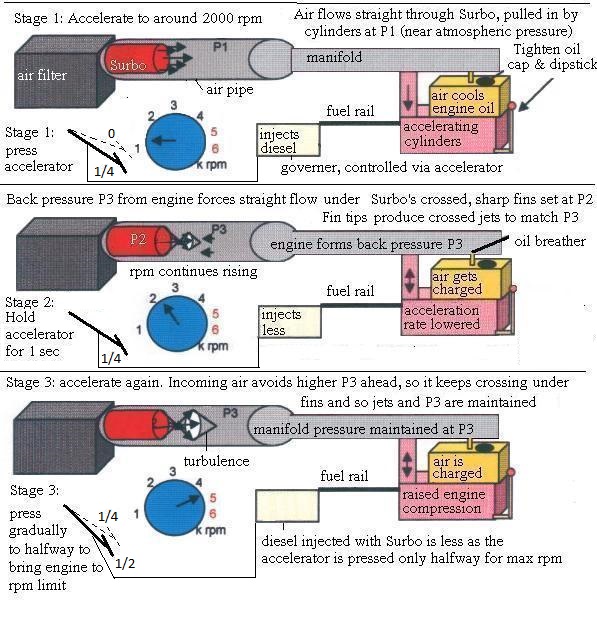

















Diagram below shows the air pressure build-up within the Surbo system as the Surbo is activated through Stages 1 to 3.

where P1 is the initial inlet absolute air pressure, P2 is the Surbo's pressure setting, and P3 is the back pressure formed by the temporarily decreased acceleration.
| Stages/ {Surbo System Component} | {Surbo (red), presses air into grey pipe} |
{Oil chamber, in orange} | {Governer, controlled by accelerator, in white box} | {Intake manifold, in light grey} | {Engine, bottom block in pink} | {Exhaust, not shown} |
| initial acceleration (Stage 1) | air flows straight through Surbo |
Accelerator is pressed and governer injects diesel for acceleration | normal absolute pressure | is main energy source in stage 1 | ||
| pressure accumulation (Stage 2) | Surbo begins to cross-jet the air and form vortex internally |
fills up with engine back pressure | Accelerator is held still for 1 second to reduce engine acceleration, to generate a backward air pressure towards the Surbo | fills up with engine back pressure | cylinder pressure increases due to lessened acceleration but air still rushing in | exhaust back pressure increases, ready to blast air out |
| vortex (Stage 3) | Surbo spins air within itself, drawing more air in |
acts as air pressure accumulator | Accelerator is pressed slightly more around the half way point | back air pressure level is maintained | higher cylinder compression because of moderately increased air pressure | blasts air out instantly because exhaust already under full back pressure |
| scavenging: pulling gases through (Stage 3 and afterwards) | Surbos's internal vortex suction pulls air in harder than before |
Airtight installation means all air suction is directed through air filter, making the flow continuous | half accelerator pressure prevents smoke and over-fueling so engine is strong | higher air density imparts more force to air to overcome flow friction losses | abundance of air to completely burn the diesel injected | higher mass flow to push through exhaust or turbocharger along it |
Read the similar study for petrol vehicles.
Related pages:
Watch the video above showing how an engine revs with Surbo. Or watch it with the How it works page.
Above: video of Volvo XC90 T8 with Surbo, sprinting to 130 kph.
Above: video of Volvo XC90 T8 with Surbo, sprinting to 211 kph.
Above: video of Volvo XC90 T8 with Surbo, sprinting to 224 kph.

More torque and BHP (dyno test)
Quick revving (1/2 throttle to RPM limit)
If you are using a handphone to read this, you can press the above CHAT link to either call us, or to save our number to your contacts, and then you can message us by clicking the WhatsApp icon below.